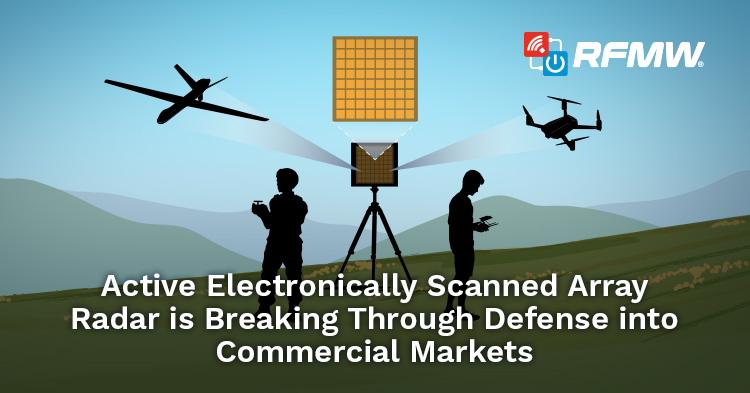
What is AESA Radar and Why It Matters
Imagine being able to “see” in every direction without moving an inch. That’s the power of
Active Electronically Scanned Array (AESA) radar systems. Unlike traditional mechanically scanned antennas, AESA radars use a grid of small Transmit/Receive (T/R) modules to electronically steer radar beams through phase shifting.
Electronic beam steering eliminates mechanical movement, enabling instantaneous beamforming and precise scanning across wide azimuth and elevation ranges. This type of precision control allows for quick beam redirection.
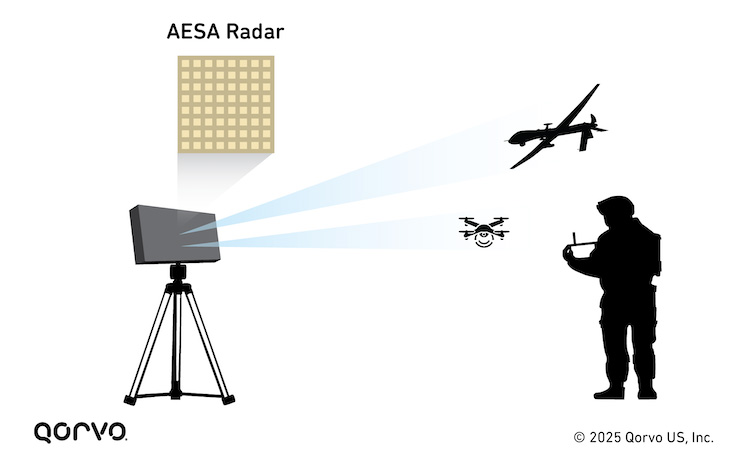
Traditionally used in defense, aerospace, and telecommunications, AESA radar has emerged as a standard solution for mission-critical applications. Operating across multiple frequency bands, the X-band (8–12 GHz) remains a preferred choice in defense for its balance of resolution, range, and atmospheric penetration. AESA architectures are also being adapted to S-, C-, Ku-, and even mmWave bands to address emerging commercial markets.
In airborne intercept radars and missile control systems, AESA delivers:
- High Pulse Repetition Frequency (PRF) and beam agility for faster, more flexible scanning.
- Track-While-Scan (TWS) and multi-target tracking capabilities for simultaneous object monitoring.
- High spatial resolution from many radiating elements and low-latency signal processing.
- Low Probability of Intercept (LPI) and Electronic Counter-Countermeasures (ECCM) functionality for enhanced resistance to jamming, interference, and adverse weather.
AESA Radar Key Benefits
From an industry-wide perspective, demand for radar systems that deliver greater speed, precision, and resilience continues to rise. AESA Technology is a clear solution, driven by advances in semiconductor materials, integration efficiency, and scalability.
- Higher Performance and Integration: Developers are seeking higher integration and miniaturization through Beamformer ICs (BFICs) and Front-End Modules (FEMs) that consolidate multiple RF functions, such as phase shifting, gain control, low-noise amplification, and switching, into a compact solution. This approach supports smaller packaging along with better efficiency and wideband performance, enabled by advanced semiconductor performance and GaN technology.
- Size, Weight, Power, and Cost (SwaP-C) Optimization: Defense and commercial programs alike are continuously seeking to reduce lifecycle costs. In the defense sector, this means lighter, more power-efficient radar payloads. In commercial applications like those in automotive, weather monitoring, air traffic control, and drone/UAV systems, lowering overall unit cost is essential to achieving greater scalability.
- Extended Detection Ranges: Critical for applications requiring precision positioning data, AESA’s enhanced sensitivity and resolution enable longer detection ranges.
- Reliability and Ruggedness: Developers seeking greater reliability & ruggedness can rely on AESA systems engineered to survive harsh environments such as airborne, naval, and automotive vibration/temperature conditions.
- Fortified Logistics: By leveraging next-gen GaN and MMIC technologies from trusted suppliers, developers can confidently design with both long-term availability and supply chain security in mind.
AESA Breakthroughs in Commercial Markets
3 Key Factors
What was once primarily reserved for defense and aerospace is now expanding into commercial applications where real-time precision, reliability, and adaptability are essential. From air traffic management to autonomous vehicles, AESA’s advantages in speed, accuracy, and control are redefining commercial industry radar techniques.
AESA systems are being deployed across a growing range of civil and industrial markets, including:
- Commercial airliners – integrated into modern weather radar systems for detecting wind shear, turbulence, and storm cells to improve flight safety.
- Air traffic management – used in ground-based systems at airports for higher accuracy when tracking aircraft in crowded airspace.

- Maritime shipping & ports – enabling port surveillance, vessel tracking, and congestion monitoring in busy waterways; paving the way for next-generation autonomous navigation.
- Autonomous vehicles – providing high-resolution imaging and object detection even in low-visibility conditions such as fog, rain, snow, or darkness, while tracking multiple moving targets simultaneously.
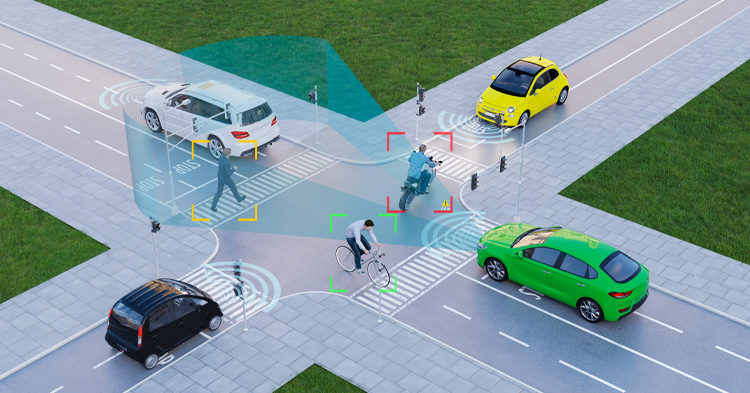
- Weather monitoring – tested for ground-based meteorology, offering faster, more detailed storm tracking and early warning capabilities.
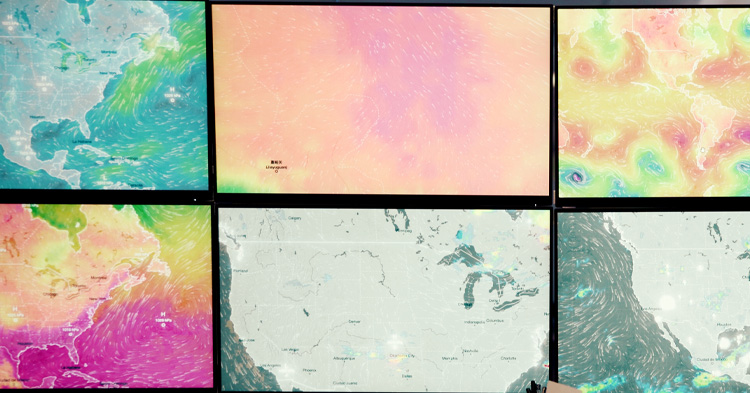
There are three key factors driving AESA’s evolution and accelerating adoption across commercial sectors:
1. Future-Proof Investment
AESA radar represents a long-term, forward-looking solution for developers and industries seeking scalable, high-performance positioning. Since modern AESA systems leverage GaN amplifiers and transistors, developers gain higher power output in a smaller footprint. This eliminates the need to combine multiple lower-powered devices, thereby reducing overall size, weight, and complexity. AESA’s multifunction agility enables seamless switching between search, tracking, targeting, and communication tasks in real time.
Additionally, its frequency agility and beam-hopping capabilities make AESA systems far more resistant to interference, jamming, and detection.
Advancements in Miniaturization
In UAV, drones, and other portable applications, the ongoing miniaturization of AESA radar systems are ideal for SWaP considerations. The reduction in weight, while maintaining, or even enhancing performance, is a significant development that is broadening the scope of AESA radar applications.
2. Operational Efficiency and Real-Time Asset Tracking
The demand for greater visibility, automation, and uptime makes AESA an optimal solution for enhanced operational efficiency and control. Commercial organizations, particularly those in logistics, aviation, and infrastructure, are turning to AESA for real-time tracking and situational awareness.
AESA’s precision and continuous scanning enable accurate monitoring of assets, minimizing loss, theft, and misplacement. Moreover, improved efficiency and fewer mechanical components reduce maintenance requirements and maximizes lifecycles, driving down total cost of ownership.
AI & ML Integration
The integration of artificial intelligence (AI) and machine learning (ML) in AESA radars is redefining how commercial operators process, interpret, and act on data. By enabling faster analysis, predictive decision-making, and intelligent automation, AI- and ML-enhanced AESA systems deliver greater situational awareness and more adaptive responses in dynamic environments.
3. Next-Generation Capabilities
AESA vs Conventional Radar Technology
The bottom line is that AESA’s combined feature set is a platform that most traditional radar can’t compete with. Its ability to track multiple targets, redirect beams instantaneously, and maintain performance in any environment sets a new benchmark for modern radar design.
For example, today’s conventional automotive radars operate at 24 GHz or 77 GHz frequency bands and are engineered with relatively low-resolution hardware.
These systems have limited beamforming capabilities, meaning they can’t precisely direct or shape their radar beams the way more advanced systems can. They often rely on:
- Mono-static or bi-static setups, where transmitters and receivers share close proximity
- Fixed or mechanically scanned beams, which reduce responsiveness to changing environments
- Few virtual channels (often between 12 and 24), restricting range and object detection capabilities
While adequate for current Advanced Driver Assistance System (ADAS) functions such as adaptive cruise control and blind-spot monitoring, traditional radar begins to fall short in more demanding situations (dense traffic, multi-lane merges, or poor weather conditions). With 88.9% of new U.S. vehicles now required to include Automatic Emergency Braking (AEB) and meet higher performance standards, AESA’s superiority in low-visibility conditions (fog, rain, snow, and glare) makes it an ideal solution for automotive compliance and safety.
In meteorological environments, about one-third of the more than 600 ground-based radar systems in the U.S. belong to the National Oceanic and Atmospheric Administration (NOAA). Many of these systems still rely on legacy Doppler radar.
Upgrading to AESA radar would deliver significant improvements in detection speed, spatial accuracy, and data refresh rates, enabling earlier warnings for severe weather events like tornadoes, thunderstorms, and hurricanes. AESA’s enhanced resolution and sensitivity make it possible to detect and predict atmospheric patterns faster and with greater precision than ever before.
Challenges Facing Commercial AESA Adoption
While AESA technology is rapidly gaining traction in commercial markets, there are several technical and economic challenges that influence overall adoption rates:
- Higher implementation costs: Each TR module utilized in an AESA array is costly to design and manufacture. However, recent breakthroughs, such as scaled-down solid-state designs, are helping make AESA a more cost-effective and commercially viable option.
- Thermal management complexity: AESA systems generate substantial heat from their power amplifiers and active electronic components. From a design perspective, thorough consideration of thermal management and cooling are essential to prevent performance degradation, maintain reliability, and extend system life – particularly in compact or enclosed environments.
- Power consumption: The high number of active modules in AESA architectures can lead to significant power draw. This poses challenges for smaller platforms such as drones, electric vehicles, and portable systems. Luckily, advances in power-efficient GaN devices and adaptive power control techniques are helping mitigate this limitation.
- Compact platform integration: Incorporating AESA technology into space- and weight-constrained platforms remains a significant engineering challenge. Designing arrays that maintain performance while fitting within the limited real estate of autonomous vehicles, UAVs, or mobile infrastructure requires continued innovation in miniaturization and system integration.
Key Technologies Taking AESA Beyond Defense
GaN Power Amplifiers
GaN) power amplifiers have become a cornerstone of next-generation AESA design. Offering higher power density, efficiency, and thermal performance than legacy Gallium Arsenide (GaAs) devices, GaN enables each transmit/receive (T/R) element to deliver greater output power while simplifying system architecture.
Highly Integrated Beamformers
Beamformers are essential to AESA operation, shaping and steering multiple antenna beams with precision. Modern AESA systems employ analog, digital, or hybrid beamforming techniques, depending on mission requirements and system tradeoffs.
Today, the most common configuration is a hybrid architecture, which combines the flexibility of digital control with the efficiency of analog signal management.

Analog & Digital Beamforming Advantages
By consolidating multiple RF functions—such as phase shifting, gain control, low-noise amplification, and switching—into a single device, integrated beamformers significantly reduce system complexity, cost, and size. This enables phased-array performance even in space-constrained platforms.
Wideband and Software Defined Architectures
Modern AESA radar systems are evolving toward wideband, software-defined operation, offering the flexibility to perform multiple roles—such as tracking, collision avoidance, and weather monitoring—on a single platform without extensive hardware redesign.
Advanced Switching and Control
Fast, low-loss, high-power switches improve scan rates and system reliability, supporting real-time monitoring in applications like air traffic and maritime management.
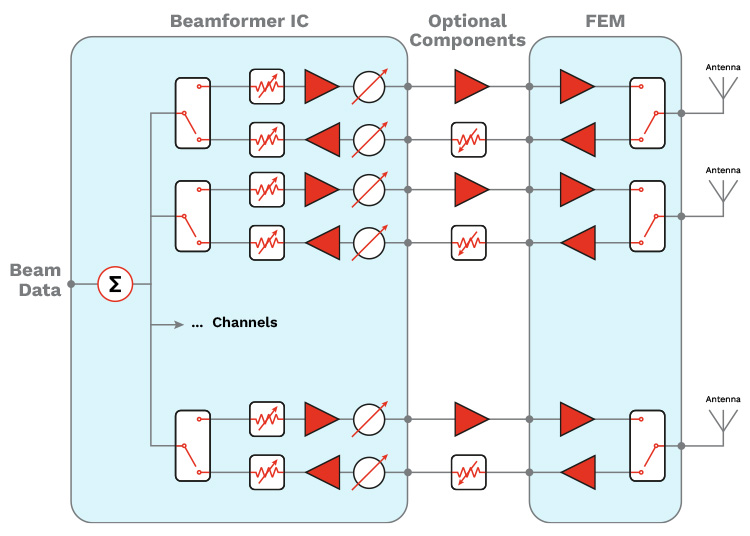
Featured Products
GaN Power Amplifiers:
The Guerrilla RF GRF0012 is a wideband, 12 W GaN-on-SiC HEMT covering DC to 12 GHz with 16.5 dB saturated gain and 60% drain efficiency, supporting both pulsed and linear operation. Housed in a compact 3 × 3 mm QFN package, it’s ideal for space-constrained AESA, radar, and instrumentation systems that demand high output power and broadband performance.
Qorvo’s QPA2598 GaN driver amplifier operates from 6 to 12 GHz, delivering 2.5 W output power, 16 dB power gain, and 30% PAE, making it a strong match for driving high-power GaN HPAs in X-band radar and EW systems. Its 4 × 4 mm QFN package and shared voltage rail compatibility simplify integration in compact, multi-stage AESA front ends.
Beamformers:
The Axiro F6415 is an 8 to 12 GHz beamforming IC offering independent gain and phase control, fast digital interfacing, and integrated DACs and ADCs, enabling precise beam steering in compact X-band AESA radar and SATCOM systems.
Qorvo’s AWS-0103 is a quad-core BFIC supports 6-bit phase and gain control across four channels, with dual-beam receive and SPI daisy chaining for scalable AESA designs in radar and 5G systems. When paired with the AWMF-0106 front end, it forms a compact, high-power antenna solution optimized for low SWaP-C.
GaN Switches:
The Finwave FW2001 is a wideband GaN SPDT switch operating from 30 MHz to 12 GHz with 20 W pulsed power handling, 85 ns switching speed, and hot switching capability, making it ideal for high-reliability radar systems across L through X bands.
Qorvo’s QPC2040 SPDT GaN switch operates from 8 to 12 GHz with 10 W input power handling, sub-1.2 dB insertion loss, and 35 ns switching speed, delivering robust performance for high-power AESA radar and EW systems.
Front End Modules:
The Qorvo QPF5010 is an integrated X-band front-end module combining a T/R switch, limiter, LNA, and 10 W PA in a compact footprint, offering a 2.2 dB receiver noise figure for high-efficiency AESA radar performance.
LNAs:
The ADM-10713PSM from Marki Microwave covers 12 to 18 GHz and delivers 27.3 dB gain with a 1.6 dB typical noise figure. Operating from a single 3 V supply at just 8 mA, this LNA is optimized for low-power phased arrays and SATCOM front ends where noise and power budgets are tight.
Qorvo’s CMD319C3 is a broadband MMIC LNA delivering 20 dB of gain with an impressively low 0.92 dB noise figure at 10 GHz. Housed in a compact 3×3 mm QFN package and internally matched to 50 ohms, it supports space-constrained AESA, EW, and X-band radar designs without the need for external matching components.
Driver Amplifiers:
The MPD4-0422CSP2 is a 4–22 GHz, 4-way MMIC power divider/combiner offering high 30 dB isolation, low 1 dB insertion loss, and exceptional amplitude and phase balance. Its ultra-compact 2.5 mm CSP2 package enables significant SWaP reduction, making it ideal for high-density AESA, EW, and SATCOM systems.
Qorvo’s QPL3050 is a broadband driver amplifier covering 6–14 GHz, delivering 19 dB gain and 20 dBm output power with low current draw from a single 5 V supply. With integrated 50-ohm matching and a compact 3×3 mm footprint, it supports efficient, space-constrained AESA and EW front-end designs.
Variable Attenuators:
The Axiro F2251 is a voltage-variable attenuator covering 50 MHz to 6 GHz with 33.6 dB of linear-in-dB attenuation range, low 1.4 dB insertion loss at 2 GHz, and excellent linearity up to +67 dBm IIP3. With enhanced phase noise performance and a compact 3×3 mm package, it supports high-fidelity signal control in space-constrained RF systems.
Qorvo’s QPC0045 is a 6-bit digital step attenuator operating from 10 MHz to 48 GHz, offering 31.5 dB attenuation with ultra-fine 0.5 dB steps and sub-0.1 dB step error. With flexible control interfaces (parallel, SPI, I²C) and low DC power consumption, it’s ideal for precise, wideband AESA designs.
The Qorvo QPC1008 combines a 5-bit GaAs DSA with a 1 dB analog VVA, delivering 32 dB of total attenuation from a compact 3.9×3.9 mm package. Operating with negative control voltages and matched to 50 ohms, it offers low 5.5 dB insertion loss at 10 GHz for efficient amplitude control in radar and phased array systems.
Conclusion: Building Smarter Radar Systems with the Right Components
As AESA radar technology accelerates into commercial markets, selecting the right RF components becomes a critical part of system success. From beamformers and front-end modules to high-speed switches, LNAs, and attenuators, every element must deliver high performance, compact integration, and long-term reliability to meet today’s evolving radar requirements.
At RFMW, we work closely with leading suppliers like Qorvo, Axiro, Marki Microwave, Finwave, and others to offer a curated portfolio of components optimized for AESA system design. Whether you’re developing radar for aerospace, automotive, weather monitoring, or advanced logistics, our RF engineering team is here to help.
Have a design in progress? Contact RFMW today to get expert guidance on product selection, design integration, and performance optimization for your AESA radar system.

